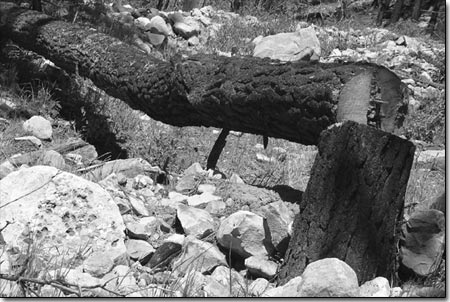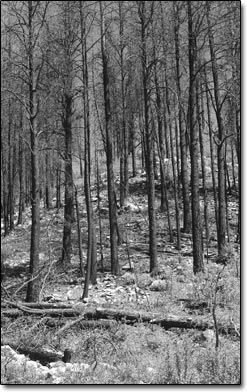|
Conservationists say damaging new public land policies expected
this week
by Missy Votel
 |
| The charred remains of a downed
tree lie across an opening just below Lake Vallecito. New
forest management policy reforms are expected this Friday
in the name of streamlining the forest planning process. But
local conservationists fear the reforms will cut the public
out of the loop and eliminate wildlife monitoring requirements./Photo
by Todd Newcomer. |
Management of the local forest could be in store for a George
W. Bush facelift in the near future. Local conservationists expect
that new national environmental policies, which will exclude the
public from control of public lands and eliminate wildlife monitoring,
will be announced this Friday. They fear that these new policies
will have negative impacts here and throughout the country. Meanwhile,
the local Forest Service is taking a wait-and-see approach.
Mark Pearson, executive director of San Juan Citizens’
Alliance, and Jeff Berman, executive director of Colorado Wild,
both believe that the Bush administration will make a long-awaited
announcement this Friday afternoon. The announcement is expected
to make public the finalization of new regulations for planning
on national forest lands. Pearson, Berman and conservationists
throughout the country are expecting a further watering down of
environmental regulations.
“It promises to be a typical expansion of the administration
throwing away environmental regulations that get in the way of
resource development,” Pearson commented.
Berman agreed, saying, “Eliminate environmental analysis
and protection, reduce or eliminate public involvement and promote
local control only when it suits administration purposes. That
to me is the Bush administration’s philosophy on public
lands management.”
At face level, several of the proposals are intended to streamline
federal review and cut down on wasted tax dollars. However, in
many cases the streamlining would come at the expense of public
involvement. One draft regulation would make intensive environmental
impact statements optional for revisions of forest plans. Forest
plans represent the guiding spirit of areas like the San Juan
National Forest, which interestingly has recently begun a revision.
The San Juan National Forest first undertook a revision of its
forest plan beginning in 1995. After a several-year-long delay
in 1998, work on the plan resumed recently.
Berman and Pearson said that new, lighter standards could carry
long-standing local impacts if they influence this long-awaited
forest plan revision.
“They want to eliminate any public input or involvement
in the creation or revision of forest plans and that’s the
zoning for the forest,” Berman said. “The Forest Service
would be allowed now to categorically exclude the public from
the process.”
 |
Burned trees cover a hillside below Lake
Vallecito.
A plan to log the burned trees near Vallecito was
halted after Colorado Wild filed a lawsuit. However, new policy
reforms could put the logging
operation back on track./Photo by Todd ewcomer. |
Pearson added that the San Juan National Forest would be ending
a good track record of public involvement if it chose to follow
lighter regulations. “If they throw out these regulations,
they’ll be avoiding steps they’ve taken in the past
like involving the public and doing detailed analysis,”
he said.
Pearson added that he hopes the local Forest Service will honor
a commitment to public process. However, he said that the nearby
Grand Mesa, Uncompahgre and Gunnison (GMUG) National Forest has
already announced its intention to limit public involvement.
“The GMUG forest has already announced that they’ll
do everything they can to take advantage of this policy,”
he said. “I had hoped that the San Juan National Forest
would not. Whether they’ll get some more rigorous marching
orders from above is hard to tell.”
Another proposed rule change that poses a direct local threat,
according to Pearson and Berman, is the end of wildlife monitoring.
Currently, the Forest Service is required to monitor Management
Indicator Species for major projects like the Missionary Ridge
Timber Sale or the development of natural gas in the HD Mountains.
“Management Indicator Species are those canaries in the
coal mine that need to be evaluated,” Berman said.
The draft regulations expected to be made final this Friday would
eliminate that monitoring requirement altogether. In late January,
Judge Zita Weinshienk ruled in favor of Colorado Wild’s
lawsuit challenging the salvage logging the Missionary Ridge burn
area. She credited the ruling to the local Forest Service’s
failure to monitor Management Indicator Species in the area.
“This was the issue that was so egregious on the Missionary
Ridge Timber sale that the judge ruled in our favor,” Berman
said.
Now, that requirement could go away courtesy of the proposed
regulations. Berman added, “This directly relates to the
logging of Missionary Ridge and whether it may or may not be able
to move forward.”
The elimination of the monitoring requirement also has ramifications
for the HD Mountains, the roadless area near Bayfield proposed
for extensive gas development.
“It’s been very inconvenient for the Forest Service
because they haven’t collected any data on Management Indicator
Species for 22 years, and they’re running into a wall in
places like the HDs,” Pearson said.
He added that the rule change would offer land managers here
and elsewhere an easy out.
“They’ve never prioritized collecting data about
wildlife and rather than doing that now, they’d rather throw
out the regulation,” he said.
Thurman Wilson, assistant manager for the San Juan Public Lands
Center, said that the San Juan National Forest is not jumping
to conclusions on the draft regulations that may be made final
this week. In the case of the ongoing forest plan revision, he
said that there is no intention to cut out the public.
“If the new planning regulations do come out in final,
I feel confident that we’ll have a choice and we’ll
be able to make a conscious decision,” Wilson said.
He added, “Our intention and all the earlier regulations
have stressed working with the community and reaching consensus.”
Wilson said that regardless of the new regulations, this approach
should become evident this fall and winter. At that time, the
forest plan revision will reopen to public scrutiny. A draft of
the revised direction for the management of much of the area’s
public lands should be available in the fall of 2005.
However, Pearson and Berman have their eyes on the more immediate
future and are expecting news this Friday at 3 p.m. Eastern Standard
Time. “Typically, that’s when the Bush administration
releases its most damaging policies and news,” Berman said.
“There’s a reason for it. Most of the media has already
gone home for the weekend.”
|

